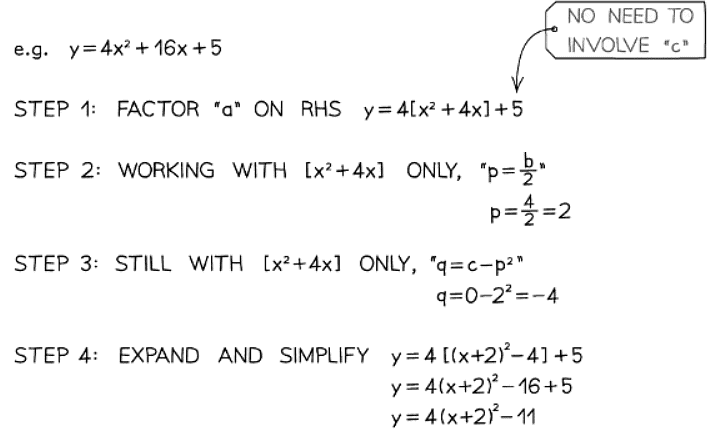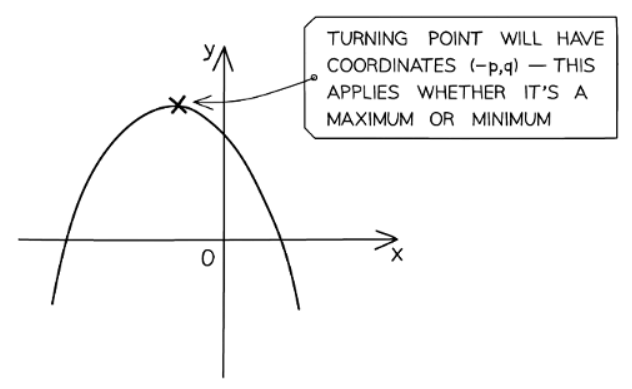Class 10 Exam > Class 10 Notes > Mathematics for GCSE/IGCSE > Completing the Square
Completing the Square | Mathematics for GCSE/IGCSE - Class 10 PDF Download
Completing the Square
How can I rewrite the first two terms of a quadratic expression as the difference of two squares?
- Consider the quadratic expression x2 + bx + c.
- The first two terms can be expressed as the difference of two squares using the following principle: x2 + bx is equivalent to (x + p)2 − p2, where p is half of b.
- To verify this, expand the right-hand side.
- Is x2 + 2x equivalent to (x + 1)2 − 12?
- Yes, as (x + 1) − 12 = x2 + 2x + 1 − 1 = x2 + 2x.
- Is x2 + 2x equivalent to (x + 1)2 − 12?
- This holds true for negative values of b as well.
- For instance, x2 − 20x can be expressed as (x − 10)2 − (−10)2, which simplifies to (x − 10)2 − 100. Notably, a negative b does not change the sign at the end.
How do I complete the square?
- Completing the square is a way to rewrite a quadratic expression in a form containing a squared-bracket
- To complete the square on x2 + 10x + 9
- Use the rule above to replace the first two terms, x2 + 10x, with (x + 5)2 - 52
- then add 9: (x + 5)2 - 52 + 9
- simplify the numbers: (x + 5)2 - 25 + 9
- answer: (x + 5)2 - 16
How do I complete the square when there is a coefficient in front of the x2 term?
- You first need to take a out as a factor of the x2 and x terms only

- Use square-shaped brackets here to avoid confusion with curly brackets later
- Then complete the square on the bit inside the square-brackets:

- This gives

- where p is half of b/a
- This gives
- Finally multiply this expression by the a outside the square-brackets and add the c

- This looks far more complicated than it is in practice!
- Usually you are asked to give your final answer in the form

- Usually you are asked to give your final answer in the form
- For quadratics like -x2 + bx + c, do the above with a = -1

How do I find the turning point by completing the square?
- Completing the square aids in locating the turning point on a quadratic graph.
- When the equation is y = (x + p) 2 + q, the turning point is situated at (−p, q), noting the negative sign in the x-coordinate.
- This concept connects to graph transformations, where y = x 2 is shifted by p to the left and q upwards.
- Even with a coefficient, if y = a(x + p) 2 + q, the turning point remains at (−p, q).
- If a > 0, the turning point is at a minimum, while if a < 0, it is at a maximum.
- Additionally, completing the square assists in formulating the equation of a quadratic when the turning point is given.

- It can also be used to prove and/or show results using the fact that any "squared term", i.e. the bracket (x ± p)2, will always be greater than or equal to 0
- You cannot square a number and get a negative value

Solving by Completing the Square
How do I solve a quadratic equation by completing the square?
- To solve x2 + bx + c = 0
- replace the first two terms, x2 + bx, with (x + p)2 - p2 where p is half of b
- this is called completing the square
- x2 + bx + c = 0 becomes
- (x + p)2 - p2 + c = 0 where p is half of b
- x2 + bx + c = 0 becomes
- rearrange this equation to make x the subject (using ±√)
- For example, solve x2 + 10x + 9 = 0 by completing the square
- x2 + 10x becomes (x + 5)2 - 52
- so x2 + 10x + 9 = 0 becomes (x + 5)2 - 52 + 9 = 0
- make x the subject (using ±√)
- (x + 5)2 - 25 + 9 = 0
- (x + 5)2 = 16
- x + 5 = ±√16
- x = ±4 - 5
- x = -1 or x = -9
- If the equation is ax2 + bx + c = 0 with a number in front of x2, then divide both sides by a first, before completing the square
How does completing the square link to the quadratic formula?
- The quadratic formula actually comes from completing the square to solve ax2 + bx + c = 0
- a, b and c are left as letters, to be as general as possible
- You can see hints of this when you solve quadratics
- For example, solving x2 + 10x + 9 = 0
- by completing the square, (x + 5)2 = 16 so x = ± 4 - 5 (from above)
- by the quadratic formula,
 (the same structure)
(the same structure)
- For example, solving x2 + 10x + 9 = 0
The document Completing the Square | Mathematics for GCSE/IGCSE - Class 10 is a part of the Class 10 Course Mathematics for GCSE/IGCSE.
All you need of Class 10 at this link: Class 10
|
38 videos|413 docs|19 tests
|
Related Searches















